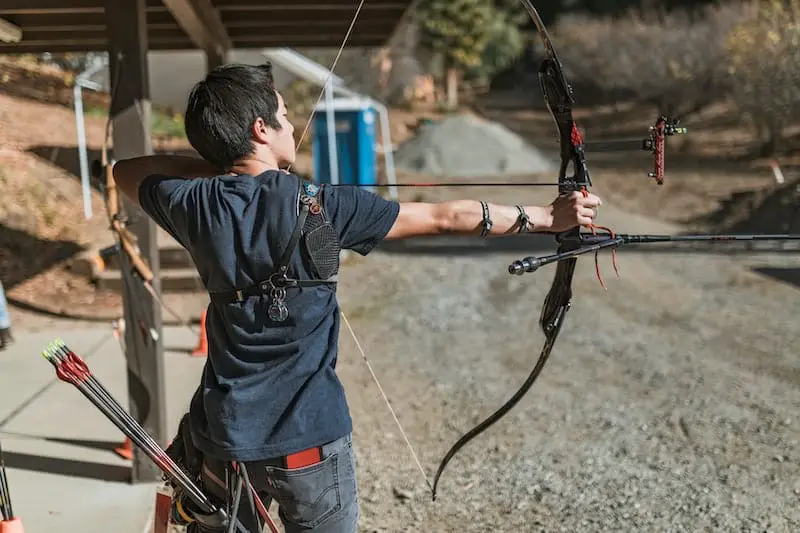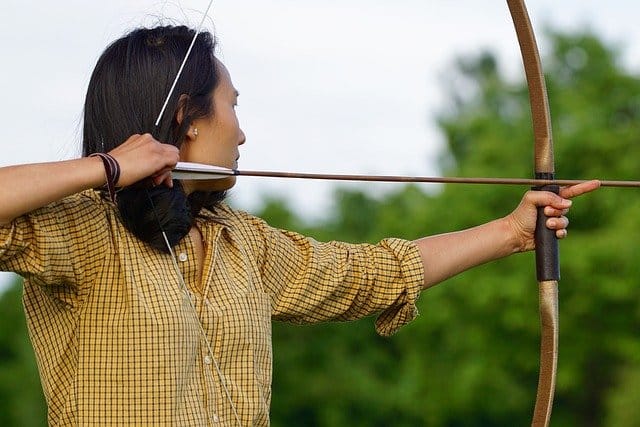Have you ever wondered what the differences are between a recurve and a composite bow? There are quite a few differences between a recurve and a composite bow. And we will help to demystify the differences.
The major difference between a recurve and a composite bow is that they are made of different materials. A recurve bow can be made of wood most of the time. A composite bow is made from multiple natural materials. Both bows have the same shape and can be interchangeably referred to as recurve bows.
In this post, we will cover the differences between recurve and composite bows. Keep reading to learn about how these bows are different and similar to each other.

The Differences Between a Recurve Bow and A Composite Bow
A recurve bow and a composite bow are different from each other. The recurve bow describes the style and shape of a bow that is most used by archers. A composite bow refers to the material with which the bow is made; generally, this is a laminated bow.
Both terms are common in the archery world. And it can be confusing to figure out what they all mean. Recurve refers to the shape of a bow. Composite refers to the materials the bow is made out of.
Parts of the Bows
Because the recurve and composite bows are both technically the same shape bow, they have similar parts. The recurve bow is standard for beginners, and it has all of the basic parts of your classic bow.
The following is a list of the common parts of both recurve and composite bows:
- Upper limb
- Lower limb
- Grip
- Arrow rest
- Nocking point
- Bowstring
- String grove
- Sight window
These are the common parts of both bows, and in essence, because a composite bow is the same shape as a recurve bow, all of their parts are the same. The composite bow differs from a recurve in that it is made out of different materials, so the upper limb and lower limb are composite instead of wood.
What Is a Recurve Bow?
A recurve bow is a style of bow that is most common among Archers. This style has a simple design and is what you think of when you think of a bow and arrow. It is based on many of the original style bows that Native Americans and other indigenous peoples used.
A recurve bow is generally made of wood and can be made from a single piece of wood. But there are other ways to manufacture a recurve bow, especially the more modern bows.
Most recurves have two or three parts that make up the bow. The exterior and core of the recurve can also be different materials or the same, depending on the manufacturer.
A recurve bow can be made of any of the following materials:
- Wood core
- Carbon foam core
- Layers of fiberglass
- Carbon exterior
- Wood exterior
Here you can see the overlap between what a recurve bow is and what a composite bow is. Composite bows can also be made of wood and have the same shape as a recurve bow. Putting them in the category of recurve bows because recurve describes the shape of a bow and not necessarily its material composition.
The Advantages of a Recurve Bow
There are quite a few advantages to using a recurve bow. Because a recurve bow is the same shape as a composite bow, some of these will be overlapping advantages. But the recurve bow is slightly different from the composite bow, so we highlight them separately.
The following is a list of advantages for the recurve bow:
- Ability to disassemble
- Easy to use
- Faster shot
- Great for beginners
- Increased stability
- A lower starting price point
These advantages make the recurve bow one of the most popular bows of choice among archers at all levels. However, beginners are the most likely to be using a recurve bow. It is good to start a new archer using a recurve bow because it is easy to use and easy to learn.
The Disadvantages of a Recurve Bow
As far as disadvantages go, there are some for the recurve bow. The recurve bow, like the composite bow, has some flaws, but it works fairly well to do its job.
The following is a list of disadvantages for the recurve bow:
- Can be seen as less powerful
- Does not allow for high draw weights
- Increases the likelihood of fatigue with each use
- Practice is needed often to maintain performance
- Requires lots of technique for proficiency
Recurve bows were used by many different groups of people throughout history. The following is a list of these people who used recurve bows.
This is a list of who historically used recurve bows:
- Alans
- Bulgars
- Chinese
- Cumans
- Dacians
- Greeks
- Huns
- Hyksos
- Koreans
- Magyars
- Mongols
- Parthians
- Persians
- Sarmatians
- Scythians
- Turks
What Is a Composite Bow?
A composite bow tends to be the same shape as a recurve bow; however, the composite bow can be made of different materials. To be clearer, a composite bow has the same shape as a recurve bow. And many times, a composite bow will be called a recurve bow.
A composite bow is generally made of any combination of the following materials:
- Horn
- Wood
- Sinew
- Laminate
Since the composite bow is made from a few different materials, it comes with both its advantages and disadvantages.
The Advantages of a Composite Bow
There are many different advantages to a composite bow. This is mainly because they are made up of a combination of different materials. And many of these advantages are also advantages of a recurve bow because composite and a recurve bow have the same shape.
The following is a list of advantages of a composite bow:
- Higher draw weight
- Better storage of energy
- Best for non-mounted archers
- Higher arrow velocity
As you can see from the list of advantages, a composite bow is a great tool for shooting arrows. It can be used for mounted archers, but it does better for archers on the ground.
Many groups found the composite bow to be advantageous back in the day.
List of the different composite bows developed around the world.
- Mongol bow
- Korean bow
- Chinese bow
- Scythian bow
- Hungarian bow
- Turkish bow
- Perso-Parthian bow
As you can see, a lot of these groups were listed with the recurve bow, as well. And this makes sense because composite bows fall under the umbrella term of recurve bows.
The Disadvantages of a Composite Bow
A composite bow has many disadvantages as well. The composite bow has disadvantages mainly due to its construction. And hence why you might choose a recurve bow over a composite bow.
The following is a list of disadvantages of a composite bow:
- More time and material needed to construct
- Not as strong in high humidity when made with animal glue
- Hard to keep dry
As you can see from the list of disadvantages, a composite bow tends to have more construction issues than a recurve bow. But these two bows are not the only shape of bow you can find on the market.
The Different Styles of Bow
There are a few different styles of bows that you can use in archery. And the most common type of bow used in archery is a recurve bow. The recurve bow refers to the shape of the bow. But in modern language, the recurve bow has turned into a synonym for composite bows.
Often people will use the word “recurve” to describe a bow of a specific shape, whereas composite refers to the materials out of which the bow is made. A composite bow is always going to be a recurve bow.
The following different types of bows are available for purchase:
- Composite
- Compound
- Recurve
Many times, you will see recurve and composite bows under the same category. Since a composite bow has a recurve form, they tend to be grouped.
Again, the recurve bow is a type of bow, but also the shape of the bow. And a composite bow, while it has the shape of a recurve bow, is made up of different materials.
What Are Compound Bows?
One new term is compound bow. A compound bow is a different type of bow in that it has a different shape, and it is made from different materials. A compound bow has a pulley system that the bow uses to draw back the bow.
Compound bows can be made from aluminum, carbon fibre, or other metallic alloys. Compound bows are very different from both recurve and composite bows.
It can be tricky to keep track of the differences between a composite bow and a compound bow. Both bows have very similar names, and this can come with some confusion.
However, compound bows are very different in shape from a recurve or a composite bow. Compound bows use a cam system that allows the archer to use less force and draw a higher weight.
The Advantages of Compound Bows
Compound bows have many advantages that make them more desirable than recurve or composite bows. However, a recurve is not without its advantages, and we will get there later.
The following is a list of advantages of compound bows:
- Built-in draw stops
- Built-in mechanical release
- Can have site system attached
- Less recoil and vibration
- Maximizes energy storage with Cam systems
- Shoots faster
- Stores more energy
The compound bow has a lot of advantages, especially during competition. This is the type of bow that you see athletes use on the regular. Because it has a mechanical release and sites, it is very easy for hunters to use as well. With a compound bow, you do not need to have the same level of skill.
Why does a compound bow have three strings?
The Disadvantages of a Compound Bow
There are many different disadvantages of a compound bow. There can be both technical and circumstantial disadvantages depending on who you talk to about compound bows. Remember, a compound bow is different from a composite bow, and so they’ll have very different disadvantages.
Again, because a compound bow is more complicated, it tends to have a few different disadvantages. Compound bows are most often used in competition because they do come with a lot of advantages. They are also used quite often in hunting because of their accuracy. With a compound bow, it does not require a lot of skill and form for the archer to do well.
The following is a list of disadvantages of compound bows:
- Dry firing is very dangerous and damaging
- Extremely sensitive to shooting form of the archer
- Heavier bow to hold
- Lots of moving parts
- Often requires mechanical draw aid due to potential torquing of the bowstring when drawing with just the hands
- Specialized tools required for maintenance and adjustments
Now you know the difference between a composite and a recurve bow. And as a bonus, you know what a compound bow is in comparison to both types of bows. Hopefully, your knowledge surrounding archery and bows is that much more defined.
Why is it called a MODERN Composite Bow?
A modern composite bow is a relatively recent development in the history of archery. The use of composite materials is a relatively new development, and it has only been in the last few decades that composite bows have become widely available.
The term “modern” is used to distinguish these bows from traditional bows, which were typically made from a single piece of wood or other natural materials.
The use of modern materials such as carbon and glass fibers, advanced lamination techniques and manufacturing technology that allows for precise control of the bow’s shape and performance, set these bows apart from traditional bows. The older and traditional bows use natural materials such as bamboo, horn and sinew.
Modern composite bows have the advantage of being more consistent in their performance, and more durable, which makes them more suitable for modern archery competitions, hunting and recreational use.
Final Thoughts: Composite and Recurve Bows Aren’t That Unlike
Composite and recurve bows are bows of the same shape. The biggest difference between these two bows is the materials they are made from. Additionally, the composite and recurve bows have different histories, but that is mainly because they are referred to differently throughout time.
Both types of bows are considered to have a recurve shape. The composite bow tends to be stronger and easier to use. But the recurve bow tends to last longer due to its construction.


